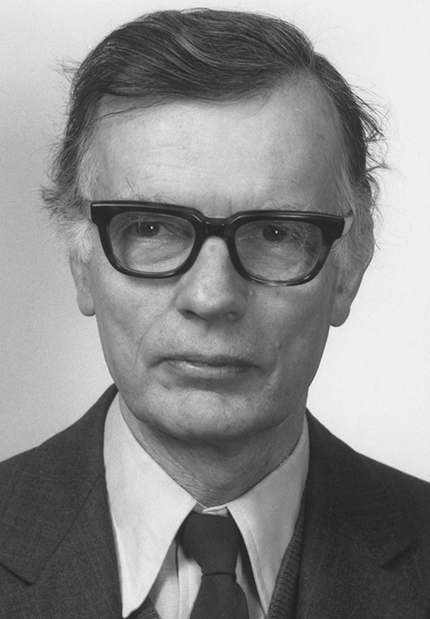Jan Korringa
DOI: 10.1063/PT.3.3147
Jan Korringa, one of the most respected condensed-matter theorists of the past century, died on 9 October 2015 at his home in Laguna Beach, California. He was surrounded by his children and grandchildren, who remember him as a wonderful father and a compassionate human being whose love of life and physics was boundless. He was writing notes to his students in his famous illegible script, correcting their explanations of his scientific discoveries, within weeks of his death.

Jan Korringa

Born in Heemstede, the Netherlands, on 31 March 1915, Korringa received his undergraduate degree from Delft University of Technology. He went to Leiden University in 1937 to pursue his graduate studies under Hendrik Kramers. The university closed in 1940 when the Netherlands was occupied by the Nazis and the faculty went on strike in sympathy with their Jewish colleagues. Korringa returned to Delft and received his PhD in 1942 under Bram van Heel with a study of algebraic optics and also did postdoctoral work with Ralph Kronig on the theory of metals. He was hired as an associate professor at Leiden in 1946. He was a protégé of Kramers, who had been the first protégé of Niels Bohr; so Korringa’s connection with quantum mechanics started at the source.
Widely expected to be offered the chair at Leiden upon Kramers’s retirement, Korringa was not considered senior enough when Kramers died at age 58 in 1952. He was therefore free to accept a full professorship at the Ohio State University. He was a consultant to Oak Ridge National Laboratory and the Chevron Oil Field Research Co for many years. In 1962 he was awarded a Guggenheim fellowship.
Korringa’s discovery having the most far-reaching influence on condensed-matter theory is his use of multiple-scattering equations to calculate the stationary electronic states in ordered and disordered solids. During World War II, Korringa was not allowed to pursue his primary interest in condensed-matter physics. Out of necessity, he had to broaden his scientific interests, which brought him into contact with the experimental and theoretical work of Nikolai Kasterin on the scattering of acoustic waves by an array of spheres. It was natural for Korringa to consider how Kasterin’s multiple-scattering equations could be used in the context of condensed-matter physics. On a train ride from Delft to Heemstede, Korringa had the epiphany that the equations could be applied to electrons scattering from a cluster of atoms. Moreover, when the number of atoms increased without bound, the incoming and outgoing waves could be set equal to zero, which yielded a formalism for calculating the stationary states.
In a now-famous 1947 paper, Korringa showed how his multiple-scattering theory (MST) could be used to find the energy as a function of wavevector for electrons in a periodic solid. In 1954 Nobel laureate Walter Kohn and Norman Rostoker, who went on to have a successful career in nuclear physics, derived the same equations from a different starting point. What are now known as the Korringa-Kohn-Rostoker (KKR) band-theory equations are used around the world. At Oak Ridge in 1967, two of Korringa’s students, Harold Davis and one of us (Faulkner), started a program that still uses MST to calculate the electronic states in condensed matter.
Korringa realized that his equations could help calculate the electronic states of nonperiodic solids for which Bloch’s theorem does not hold. In 1958 he published an approach, now called the average t-matrix approximation, for calculating the electronic states in random substitutional alloys. That work later evolved into the coherent potential approximation (CPA). Balázs Györffy and the other of us (Stocks) combined it with the KKR theory to obtain the KKR–CPA method, which is presently used for alloy calculations. Korringa’s MST is the basis for numerous theoretical developments, including the locally self-consistent multiple-scattering theory developed by Stocks and Yang Wang; when run on massively parallel supercomputers, it can be used to simulate the electronic and magnetic states of any ordered or disordered solid with models comprising tens of thousands of atoms.
Korringa’s work is outside the usual measures for the evaluation of scientific success, in that his theories are referred to much more often than they are referenced. For example, the acronyms KKR and MST are used all the time without referencing the original 1947 paper. Another example is the Korringa relation, published in 1950 and quoted without attribution in many papers on magnetic resonance and many-body theory. The magnitude of the Korringa constant Κ and its possible deviation from a constant value is the signature of the effects of strong correlations in the electron gas. Those considerations have proved valuable in recent studies of strongly correlated electron materials and high-Tc superconductors. His name has even become an adjective: The nuclear magnetic relaxation of a material can be described as Korringa-like or non-Korringa-like.
Korringa was a quiet man not given to self-aggrandizement, but he was highly respected by those who knew him. He was an old-fashioned European intellectual in the sense that he not only was an expert in his field but also was knowledgeable about art, literature, and classical music. We miss him.
More about the Authors
J. Sam Faulkner. Florida Atlantic University, Boca Raton.
G. Malcolm Stocks. Oak Ridge National Laboratory, Oak Ridge, Tennessee.




